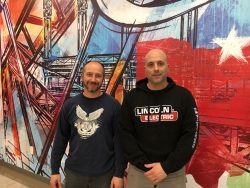Make Your Mark Series Diman Regional Vocational Technical High School
Instructors Gain Teaching Insights at the Lincoln Electric Welding Technology & Training Center

It’s a common practice for welding instructors to have industry welding experience. Today, it’s also common among career and technical schools to provide professional development opportunities for instructors, allowing even experienced teachers to advance their lab and classroom skills.
$name


$name
Instructors David Salsinha and Kevin DeSousa have both transitioned from industry to teaching at Diman Regional Vocational Technical High School in Fall River, Massachusetts. They teach a number of processes, including SMAW, GTAW, GMAW and pulse arc (pulsed GMAW welding), on materials including steel, stainless steel and aluminum. They teach welding in multiple positions and also cover various cutting methods, including plasma cutting, with students in grades 9 to 12 in a broad fabrication program.
To make sure they are up to date on teaching methods and to improve their own welding skills, Salsinha and DeSousa attended the Motorsports Basics Materials Program at the Lincoln Electric Welding Technology & Training Center in Cleveland, Ohio. The two instructors chose to travel to Ohio for their professional development experience to visit Lincoln Electric, learn from industry experts and get a look at the new Welding Technology & Training Center. The Center is intended as a showcase of current best practices in equipment, booth design, classroom design and welding curriculum. Dave and Kevin honed their skills on GTAW and GMAW, acquired knowledge regarding metallurgy and exotic materials, and discovered new ideas about gas blending. Their reaction to what they learned at the WTTC was overwhelmingly positive.
$name


$name
“Just to sit down in a professional environment and practice – without having to stop and answer student questions – was a huge benefit,” DeSousa says. “What also helped was having a professional critique of our work.”
“Plus, we saw a different teaching style,” he adds. “It’s never too late to learn new techniques.”
The instructors took back the welding, teaching and lesson planning they picked up during their experience to use in their own classrooms.
Salsinha says the instruction he and DeSousa took home from the WTTC is critical. Diman’s welding program has assumed added importance in recent years as industry in the Fall River area (about 50 miles south of Boston) are increasing their demand for skilled welders as older workers retire. “Local industry is screaming that they need welders,” DeSousa says. “There is a huge range of jobs.”
Diman works to make sure the skillsets required by local industry are being taught. One example: Diman recently began to train students on pulse arc (pulsed GMAW) because one area company needed welders with that skillset. In another instance, a shipbuilding company required welders who could MIG weld on aluminum, and Diman introduced a class to train students to meet that demand.
“We want to make adjustments based on local industry,” Salsinha points out. “We will adjust our curriculum to make sure the students learn a process that’s needed. This makes students more attractive to employers.”
Diman Regional Vocational Technical High School serves Fall River and surrounding communities. The current high school building was built 50 years ago for an enrollment of 800. During the 2017-18 school year, enrollment reached 1,400. As such, the school has entered into a feasibility study with the hope of building a new school. While Salsinha and DeSousa attended class at the WTTC, they took in how the facility is patterned, hoping to use some of that knowledge when it comes to planning a new welding area. “It’s good to see this school and bring some ideas back with us,” Salsinha notes.
Both instructors hope to come back to the WTTC for additional training, perhaps on pipe and advanced materials, and learn more about flux-cored arc welding. DeSousa hopes to return and learn more about Lincoln Electric’s U/LINC® welding and cutting curriculum. “U/LINC would help us tremendously,” he maintains.


